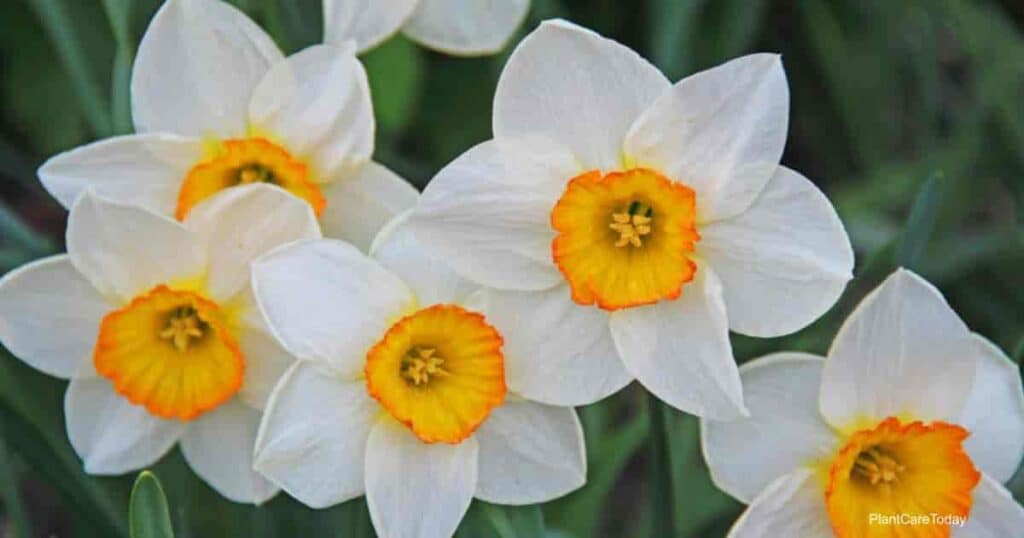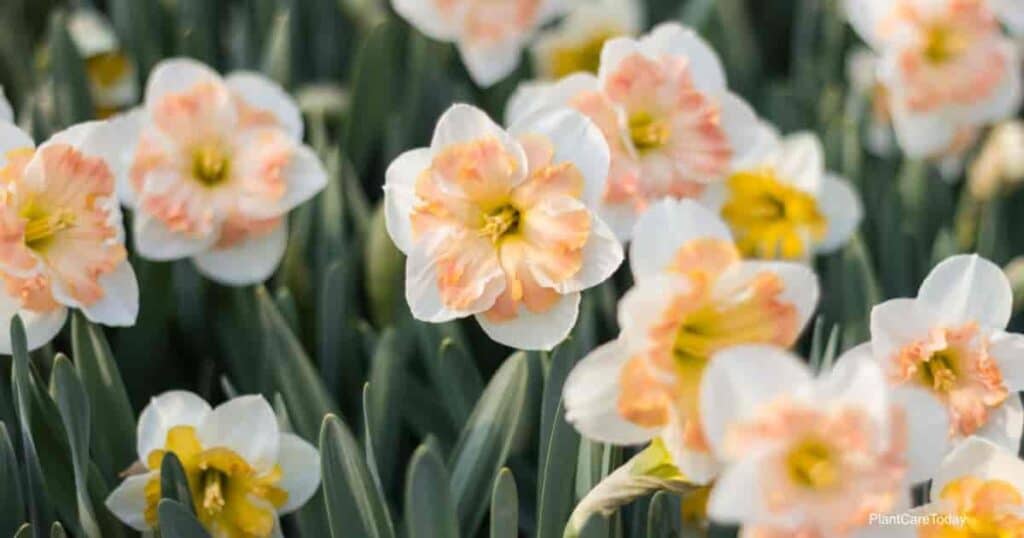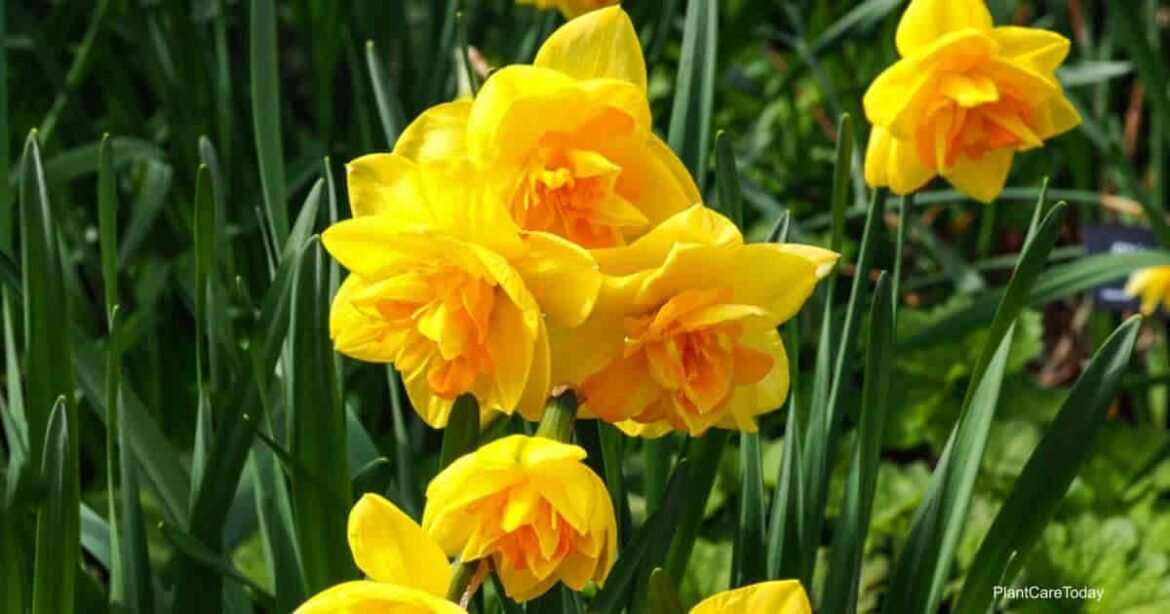Daffodils burst into bloom each spring, their bright yellow petals a symbol of renewal and hope. These cheerful flowers have captured hearts for centuries, bringing a splash of color to gardens and landscapes after the long winter months.

Daffodils are more than just pretty flowers – they have deep roots in myths and legends from many cultures. These stories reveal how important daffodils have been throughout history.
From ancient Greek tales to Welsh folklore, daffodils play key roles in stories passed down for generations.
1) The Daffodil as a Symbol of Death
In some cultures, daffodils are linked to death and bad luck. This belief stems from their early blooming season and frequent appearance in graveyards.
The bright yellow flowers often emerge when snow still covers the ground. Their sudden appearance after winter can seem eerie to some people.
Daffodils are also common in cemeteries. They’re often planted on graves because they come back year after year. This connection to burial sites has strengthened their association with death.
People think bringing daffodils inside can lead to misfortune in parts of England and Wales. They believe it might cause small poultry not to hatch or bring bad luck to the household.
Despite these gloomy associations, daffodils have positive meanings, too. They can symbolize rebirth and new beginnings, balancing out their connection to death.
2) Daffodils as Harbingers of Spring
Daffodils have long been seen as signs of spring’s arrival. These bright yellow flowers often push through the last bits of snow, signaling winter’s end.
Many cultures view daffodils as symbols of rebirth and new starts. Their appearance marks the start of warmer days and longer sunlight hours.
Some places hold special events to celebrate daffodils.
In Wales, people wear daffodils on St. David’s Day to welcome spring. In the U.S., many towns host daffodil festivals in early spring.
Daffodils’ role as spring heralds goes back centuries. Ancient Greeks linked the flowers to their myth of Persephone, whose return from the underworld brought spring each year.
3) The Connection to Narcissus
The Greek myth of Narcissus is closely linked to daffodils. In the story, Narcissus is a handsome youth who falls in love with his reflection in a pool of water.
Unable to tear himself away, Narcissus wasted away and died by the water’s edge. A beautiful flower grew in his place – the narcissus, the daffodil.
This myth gave daffodils their scientific name, Narcissus. It also made them a symbol of vanity and self-love in many cultures.
The trumpet-shaped center of daffodils is said to represent the pool where Narcissus gazed at himself. Their nodding heads are thought to show how he bent over the water.
4) Daffodils in Folklore as Good Luck Charms
Daffodils have long been seen as symbols of good fortune in various cultures. Many believe carrying or planting these cheerful flowers can bring luck and prosperity.
This belief has deep roots in rural communities, where daffodils often mark the arrival of spring. Farmers have traditionally viewed the appearance of daffodils as a positive sign for the coming harvest season.
In some areas, it’s thought that giving daffodils as gifts during Lunar New Year celebrations can bring good luck to the recipient. This tradition has been passed down through generations, reinforcing the flower’s association with fortune and success.
The daffodil’s bright yellow color likely contributes to its lucky reputation, as yellow is often linked with happiness and optimism in many cultures.
5) The Poisonous Nature of Daffodils
Daffodils have a reputation for being toxic. This stems from the fact that they contain alkaloids, particularly in their bulbs.
These compounds can cause nausea, vomiting, and diarrhea if ingested in large amounts. Animals like cats and dogs are especially vulnerable to daffodil poisoning.
Despite their toxic nature, daffodils have played a role in traditional medicine.
Ancient cultures used daffodil extracts to treat various ailments.
The Greeks and Romans believed daffodils had healing properties. They used them to treat wounds and burns. Some folk remedies also used daffodil preparations for coughs and colds.
It’s important to note that modern medicine does not recommend using daffodils for treatment. Their toxicity outweighs any potential benefits.
6) Daffodil Festivals and Their Origins
Daffodil festivals are popular events that celebrate the arrival of spring in many parts of the world. These festivals often take place in regions where daffodils bloom abundantly.
One well-known celebration is the Daffodil Festival in Nantucket, Massachusetts. This event began in the 1970s to honor the island’s daffodil-filled landscapes. It features parades, tours, and flower shows.
In the United Kingdom, the Thriplow Daffodil Weekend in Cambridgeshire has been running since 1969. This festival showcases millions of daffodils and raises money for local charities.

The Skagit Valley Daffodil Festival in Washington State is another noteworthy event. It marks the beginning of spring with vast fields of blooming daffodils and attracts thousands of visitors annually.
These festivals celebrate the beauty of daffodils and bring communities together. They often include local art displays, food vendors, and cultural performances, truly celebrating nature and community spirit.
7) Daffodils as Symbols of Hope and Resilience
Daffodils have become powerful symbols of hope and resilience in many cultures. These bright yellow flowers often bloom near water, reminding people to stay humble and look inward.
Their ability to push through frozen ground after harsh winters represents triumph over hardship. This has made daffodils a popular symbol in literature and art for overcoming challenges.
Many see daffodils as signs of renewal and new beginnings. Their appearance in early spring marks the end of winter’s darkness and the start of a hopeful new season.
In modern times, daffodils have taken on special meaning for those affected by illness. The American Cancer Society has chosen the daffodil as its official symbol of hope, representing the courage of patients and their loved ones.
Historical Significance of Daffodils
Daffodils have played important roles in ancient myths and folklore for thousands of years. These bright flowers carry deep meaning in different cultures and traditions.
Daffodils in Ancient Greece
In Greek mythology, daffodils are linked to the story of Narcissus. Narcissus was a handsome young hunter who fell in love with his own reflection. He stared at himself in a pool of water, unable to look away.

The gods turned him into a daffodil flower as punishment for his vanity. This tale gave daffodils their scientific name, Narcissus.
Ancient Greeks also used daffodils in religious ceremonies. They believed the flowers had healing powers. Priests would often wear daffodil garlands during rituals.
Daffodils in British Folklore
In Britain, daffodils have long been a symbol of spring and new beginnings. Their bright yellow blooms appear just as winter ends, bringing hope after the cold months.
Welsh people embrace the daffodil as their national flower. It represents St. David’s Day on March 1st. People wear daffodils on their clothes to mark this special day.
In some parts of England, seeing the first daffodil of spring was thought to bring good luck. Farmers believed it meant their crops would grow well that year.
Cultural Impact of Daffodils
Symbolism in Literature
Daffodils play a big role in poems and stories. William Wordsworth’s famous poem “I Wandered Lonely as a Cloud” discusses daffodils dancing in the wind. This poem shows how daffodils can make people feel happy and free.

In some books, daffodils stand for hope and new starts. Writers use them to show that good things are coming after hard times. The flower’s yellow color often means joy and sunshine in stories.
Daffodils in myths also show up in books. Greek myths tell how the flower got its name from a young man called Narcissus. This story teaches about being too proud.
Daffodils in Art
Painters love to draw daffodils. Many still-life paintings show these flowers in vases. The bright yellow petals make pictures feel sunny and alive.
Some artists use daffodils to show spring is coming. In these paintings, the flowers pop up through the snow. This tells viewers that warm days are near.
Daffodils also appear in crafts. People make fake daffodils for home decor. These crafts help bring spring inside all year long.
In garden art, daffodils often line paths or fill flower beds. Their shapes and colors make outdoor spaces look cheerful and welcoming.
Frequently Asked Questions
Daffodils have a rich history in mythology, literature, and culture. These bright flowers carry deep symbolism and are linked to fascinating stories and beliefs.
What are the origins and cultural significance of daffodils in mythology?
Daffodils have roots in ancient Greek mythology. They are closely tied to the story of Narcissus, a beautiful youth who fell in love with his own reflection. This myth gave daffodils their scientific name, Narcissus.
In Celtic folklore, daffodils symbolized purity and new beginnings. People believed these flowers could bring good luck and ward off evil spirits.
How do daffodils feature in superstitions, and what do they symbolize?

Daffodils have mixed symbolism in different cultures. In some places, they represent hope and rebirth. In others, they are linked to death and misfortune.
Chinese culture associates daffodils with good fortune and prosperity. However, bringing a single daffodil indoors was considered bad luck in some parts of England.
Can you describe the unique characteristics and classification of daffodils?
Daffodils belong to the genus Narcissus. They typically have six petals surrounding a trumpet-shaped corona.
These flowers come in various colors, including:
Daffodils usually bloom in early spring, making them popular in gardens.
What are some unusual or lesser-known facts about daffodils?
Daffodils contain toxic compounds that can be harmful if ingested. In some cultures, this poisonous nature has led to their use in traditional medicine.
Despite their toxicity, daffodils have been used to make oil. This oil was once used in perfumes and as a hair treatment.
In what ways are daffodils represented in English literature and lore?
Daffodils have inspired many English poets and writers. William Wordsworth’s famous poem “I Wandered Lonely as a Cloud” celebrates the beauty of daffodils.
In some English traditions, daffodils were associated with Lent and Easter. They were sometimes called “Lent lilies” due to their spring blooming time.

How does the story of Narcissus connect to the symbolism of daffodils in Greek mythology?
The myth of Narcissus gives daffodils a complex symbolism. They represent self-love, vanity, and unrequited love.
In Greek myth, the flower grew where Narcissus died, gazing at his reflection. This story links daffodils to themes of beauty, reflection, and transformation.
Closing
Daffodils have a rich history in myths and legends across cultures. These bright flowers are linked to rebirth, hope, and new beginnings.
In Welsh tradition, daffodils are a national symbol worn on St. David’s Day. They represent Welsh pride and identity.
Greek mythology ties daffodils to Narcissus and self-love. Celtic folklore sees them as symbols of purity and protection against evil.
Chinese culture associates daffodils with good fortune. In some dream interpretations, they signify self-love and inner growth.
These stories show how daffodils connect to human experiences. They’re more than pretty flowers – they carry deep cultural meaning.
Understanding these myths adds depth to our appreciation of daffodils. It links us to history and traditions around the world.
Next time you see daffodils, remember their rich symbolic legacy. These sunny blooms hold centuries of human hopes, fears, and beliefs in their petals.

